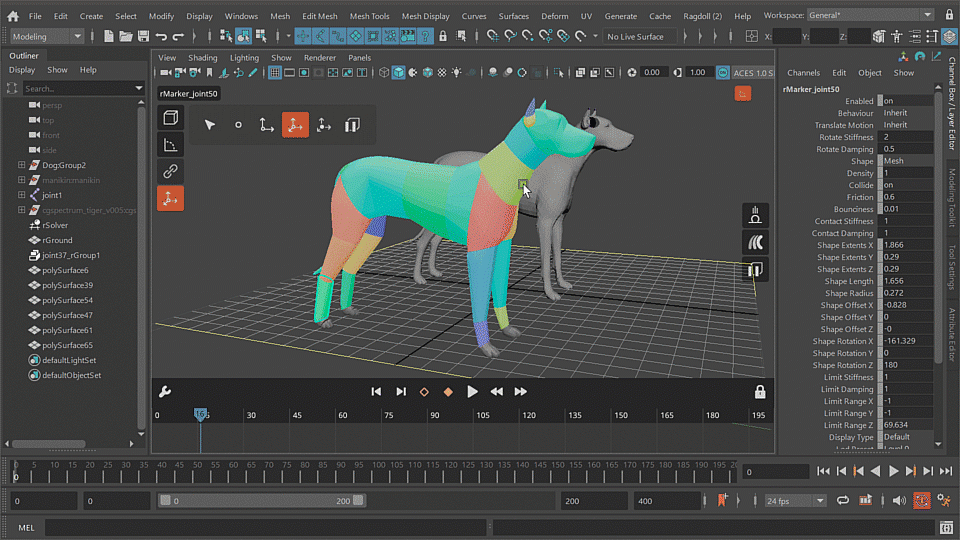Ragdoll Dynamics 3.0 helps users automate character physics in Maya, adding physically based character posing, replacement rigs for interactive frame rates and a high-res asset library.

Ragdoll Dynamics 3.0 from software developer Imbalance now includes straightforward techniques animators can use to automate character physics in Maya. The new features help users create believable, nuanced animation many times faster, with a click-and-drag interface. Update 3.0 adds physically based character posing, replacement rigs for interactive frame rates and a multi-character asset library.
Ragdoll Dynamics takes advantage of what makes overlapping animation happen in the real world – physics. Setting a body in motion needs a complex set of actions and reactions occurring in a carefully timed manner among the different parts of the body. To emulate that process in an animated sequence requires following the rules of physics in nature, but is still complicated and time-consuming to replicate with traditional animator’s tools, typically frame-by-frame, to arrive at a realistic, consistent performance.
However, because such motion follows rules, it can be automated to a large extent, leaving time for the animator to add creative, expressive nuances to the essential motion. This is what Ragdoll Dynamics is for, working as a solver that simulates animation and then generates the overlapping and follow-through motions. Marcus Ottosson, CEO and founder of Imbalance said, “Today, 80 percent of an animator’s day is spent on things that can be completely automated. With Ragdoll, you can get to a better place much faster, opening up more time for the experiments, shot complexity and the types of real-time reviews that move productions along.”
Ragdoll Dynamics is now used at around 250 studios, including Wētā FX, Sony Pictures Imageworks and DNEG, as a fast way to produce realistic secondary motion for film, episodic and game projects. Ragdoll Dynamics can be integrated with existing animation controls in Autodesk Maya, and used to depict nuanced motion in a couple of clicks, directly in the Maya viewport. Ragdoll addresses full body movement and may also be applied to cloth, hair, muscles and wings, which adds detail to different parts of a design.
The main new features in Ragdoll Dynamics 3.0 include the new click-and-drag interface described above, called Live Mode. Animators need control in their work, but instead of adding more controls to more complex character rigging, which can feel like a barrier between the artist and rig, Ragdoll blends real-time physics with the animation systems and tools.
This approach simulates physics and helps animators take over their rig as if they were playing with an action figure, selecting a part of the geometry and dragging or pulling it where they want it to go. To help, a new Interactive Mode makes it possible to use Ragdoll as a regular Maya deformer on interactive models, and see real-time updates on model contacts, limb limits and so on. Instead of keying a shot and waiting for playback, animators can see the results of changes live.
Ananimator can now open a .rag file of Ragdoll physics in an empty scene. Earlier, the physics depended on an existing character rig for export and then had to be imported later as a physics layer. Now it can be opened in a scene and used independently from an existing rig – in effect, the animator can generate physically-based versions of rigs that will be easier to animate and come from a familiar workflow, and also improve CPU performance.
A high-res Asset Library containing 14 characters is now available that animators can use to experiment with the Ragdoll feature set. A premade spaceman, alien, dog, human and others are included to create previs, test ideas or to study the physics structure and work out how to apply it to a user’s own assets. Artists can also store the ragdolls they build up in the library, and then apply the physics to future models.
Imbalance is also making their software more accessible with the launch of Ragdoll Freelancer licenses. These licenses, available to individuals only, cost USD199, include all features and are perpetual.
Ragdoll Dynamics 3.0 is available now for Autodesk Maya 2019-2023 on machines running Windows, Linux and Mac. Commercial subscription licenses are available at different rates, depending on requirements. ragdolldynamics.com


